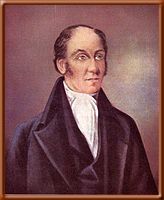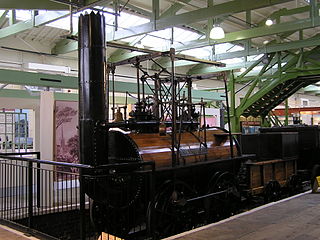| Lyon | |||||||||||||||
|---|---|---|---|---|---|---|---|---|---|---|---|---|---|---|---|
 In the Shildon museum, 2009 | |||||||||||||||
| |||||||||||||||
| |||||||||||||||
| |||||||||||||||
The Hetton Colliery Lyon or Lyons is an early British steam locomotive that still survives in preservation. It is remarkable for having continued working into the early 20th century.
| Lyon | |||||||||||||||
|---|---|---|---|---|---|---|---|---|---|---|---|---|---|---|---|
 In the Shildon museum, 2009 | |||||||||||||||
| |||||||||||||||
| |||||||||||||||
| |||||||||||||||
The Hetton Colliery Lyon or Lyons is an early British steam locomotive that still survives in preservation. It is remarkable for having continued working into the early 20th century.
The Hetton colliery railway opened in 1822 with steam traction. Although once thought to date from this time, [1] Lyon is now thought to have been built by the colliery in 1851-52. Its designer is thought to be an engineer named Young. [2] A descendant, David Young, now works on the restoration of steam engines at Beamish. [2] Lyon would have been of archaic design by 1852. The view has been put forward [3] that it was one of a pair of replicas built by Sir Lindsay Wood (1834–1920) from interest in his father Nicholas Wood's earlier designs. The other example was destroyed by a boiler explosion in 1858/1859. [3]
It was extensively rebuilt in 1882. [3] This included modern features, such as paired Salter spring balance safety valves.

The locomotive continued in service at Hetton colliery until either 1908 or 1912. [3] This was already remarkable at the time and a photograph of it was published in the Railway Magazine in 1905. [4]
It worked out its last days at the colliery driving machinery in the pit sawmill. [2] [lower-roman 1]
In 1925, the Stockton and Darlington Railway celebrated its centenary. The LNER organised a cavalcade of locomotives to commemorate this. Locomotion No. 1 was propelled by a dummy petrol engine in its tender, but Lyon was steamed and ran under its own power, [5] leading the cavalcade of fifty three locomotives. [6]
The locomotive became part of the initial collection of the National Railway Museum at York. [7] In 1974 was loaned to the new Beamish Museum where it was initially displayed in the Colliery and latterly at the Waggonway, together with working replicas of contemporary locomotives. [lower-roman 2]
In 2006 it was moved to the Locomotion museum at Shildon, but returned to Beamish in May 2011. [2] [5] [8]
There is some debate over the locomotive's original construction date, and even its name. Lowe (1975) [1] gives the name as Lyons, [lower-roman 3] but most current sources favour Lyon. Both are probably derived from the name of Hetton Lyons Colliery, which closed in 1960 and is now the site of an industrial estate and a country park. [9] [10]
The Hetton colliery railway used steam locomotives from the outset; four built in 1820 and one in 1822. They were developments of George Stephenson's earlier Killingworth design. These were of 0-4-0 arrangement with two vertical cylinders, one above each axle, and the wheels coupled by drive chains. They used steam springs for suspension, there not yet being a way of forging an adequate steel spring to carry the weight of a locomotive.
For many years, before and during preservation, it was thought that Lyon was one of this original group of locomotives, built in 1822. [4] [11] Lowe describes four named 1820 locomotives and an unnamed 1822 locomotive, which he identifies as this one, the only one to be preserved. [1] Its designers were held to be George Stephenson and Nicholas Wood.
It is now thought to have first been constructed in 1852, some years after Stephenson's death. [lower-roman 4] The design is little changed from Stephenson locomotives of the 1820s (i.e. before Rocket ) and this confused early researchers. The use of either the single flued boiler or the vertical cylinders were obsolete by Rocket. One distinctive difference from these locomotives was the enlarged smokebox with an easily opened door, providing more space for and easier cleaning of ashes. [lower-roman 5]

Two quite separate locomotives, Lyons and Eppleton, were built at the colliery much later on, [lower-roman 6] similar to those also built locally by Head Wrightson. These were small vertical-boilered well tank, with chain drive from a small vertical engine. Lyons locomotive was described in The Locomotive Magazine in 1901. [1] [14] [15]
Lowe's view is that Lyon dates from 1822 and the Lyons he describes is this later locomotive with a vertical boiler and chain drive,. [1]

George Stephenson was a British civil engineer and mechanical engineer during the Industrial Revolution. Renowned as the "Father of Railways", Stephenson was considered by the Victorians as a great example of diligent application and thirst for improvement. His chosen rail gauge, sometimes called "Stephenson gauge", was the basis for the 4 feet 8+1⁄2 inches (1.435 m) standard gauge used by most of the world's railways.

Stephenson's Rocket is an early steam locomotive of 0-2-2 wheel arrangement. It was built for and won the Rainhill Trials of the Liverpool and Manchester Railway (L&MR), held in October 1829 to show that improved locomotives would be more efficient than stationary steam engines.

John Blenkinsop was an English mining engineer and an inventor of steam locomotives, who designed the first practical railway locomotive.

Timothy Hackworth was an English steam locomotive engineer who lived in Shildon, County Durham, England and was the first locomotive superintendent of the Stockton and Darlington Railway.

A steam locomotive is a locomotive that provides the force to move itself and other vehicles by means of the expansion of steam. It is fuelled by burning combustible material to heat water in the locomotive's boiler to the point where it becomes gaseous and its volume increases 1,700 times. Functionally, it is a steam engine on wheels.

Sans Pareil is a steam locomotive built by Timothy Hackworth which took part in the 1829 Rainhill Trials on the Liverpool and Manchester Railway, held to select a builder of locomotives. The name is French and means 'peerless' or 'without equal'.

The Bowes Railway, built by George Stephenson in 1826, is the world's only operational preserved standard gauge cable railway system. It was built to transport coal from pits in Durham to boats on the River Tyne. The site is a scheduled monument. The railway is open every week on Thursday, Friday and Saturday as well as on a number of event days throughout the year.

The North Tyneside Steam Railway and Stephenson Steam Railway are visitor attractions in North Shields, North East England. The museum and railway workshops share a building on Middle Engine Lane adjacent to the Silverlink Retail Park. The railway is a standard gauge line, running south for 2 miles (3.2 km) from the museum to Percy Main. The railway is operated by the North Tyneside Steam Railway Association (NTSRA). The museum is managed by Tyne and Wear Archives and Museums on behalf of North Tyneside Council.


Henry Booth was a British corn merchant, businessman and engineer particularly known as one of the key people behind the construction and management of the pioneering Liverpool and Manchester Railway (L&M), the world's first steam railway conducting both scheduled passenger services and freight.

The Hetton colliery railway was an 8-mile (13 km) long private railway opened in 1822 by the Hetton Coal Company at Hetton-le-Hole, County Durham, England. The Hetton was the first railway to be designed from the start to be operated without animal power, as well as being the first entirely new line to be developed by the pioneering railway engineer George Stephenson.
Robert Stephenson and Company was a locomotive manufacturing company founded in 1823 in Forth Street, Newcastle upon Tyne in England. It was the first company in the world created specifically to build railway engines.

Isaac Dodds and Son was a locomotive manufacturer based in the Holmes district of Rotherham, South Yorkshire, England. Isaac Dodds took over part of the works of Samuel Walker and Company in Rotherham sometime while he was Superintendent of the Sheffield and Rotherham Railway. It is likely, therefore, that he used it to maintain the company's locomotives, or even build new ones. There, however, seems to be no record.
The history of rail transport in Great Britain to 1830 covers the period up to the opening of the Liverpool and Manchester Railway, the world's first intercity passenger railway operated solely by steam locomotives. The earliest form of railways, horse-drawn wagonways, originated in Germany in the 16th century. Soon wagonways were also built in Britain. However, the first use of steam locomotives was in Britain. The invention of wrought iron rails, together with Richard Trevithick's pioneering steam locomotive meant that Britain had the first modern railways in the world.

Steam Elephant was an early steam locomotive from North East England.

George Stephenson built a number of experimental steam locomotives to work in the Killingworth Colliery between 1814 and 1826.
Lambton Collieries was a privately owned colliery and coal mining company, based in County Durham, England.
The Lambton Railway was a private industrial railway in County Durham, England, constructed initially as a tramway from 1737, to enable coal to be transported from Lambton Collieries to the Port of Sunderland. It closed under the ownership of the National Coal Board in August 1967.

Steam springs or steam suspension are a form of suspension used for some early steam locomotives designed and built by George Stephenson. They were only briefly used and may have been used for fewer than ten locomotives.

Beamish Museum contains much of transport interest, and the size of its site makes good internal transportation for visitors and staff purposes a necessity.
The above engine was constructed in 1822 and is at the present time at work in the County of Durham.
Beamish photostream @ Flickr